Poirot: Series 3 Blu-ray Movie
HomePoirot: Series 3 Blu-ray Movie 
Acorn Media | 1991 | 682 min | Not rated | Mar 06, 2012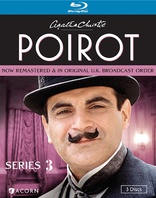
Movie rating
8.3 | / 10 |
Blu-ray rating
| Users | 0.0 | |
| Reviewer | 4.5 | |
| Overall | 4.5 |
Overview
Poirot: Series 3 (1991)
Agatha Christie's brilliant Belgian detective is on the case in the third series of this television adaptation, which aired on ITV in the U.K. and PBS in the U.S. The setting is 1930s Europe and the glittering Art Deco era, where Christie's dapper sleuth solves the thorniest of cases with his formidable intellect. Includes "The Mysterious Affair at Styles".
Starring: David Suchet, Hugh Fraser (I), Philip Jackson (II), Pauline Moran, David YellandDirector: Edward Bennett (I), Andrew Grieve, Renny Rye, Brian Farnham
| Period | Uncertain |
| Mystery | Uncertain |
| Crime | Uncertain |
| Drama | Uncertain |
| Thriller | Uncertain |
Specifications
Video
Video codec: MPEG-4 AVC
Video resolution: 1080p
Aspect ratio: 1.33:1
Original aspect ratio: 1.78:1, 1.33:1
Audio
English: LPCM 2.0
Subtitles
English SDH
Discs
50GB Blu-ray Disc
Three-disc set (3 BDs)
Packaging
Slipcover in original pressing
Playback
Region A (locked)
Review
Rating summary
| Movie | 5.0 | |
| Video | 4.0 | |
| Audio | 3.5 | |
| Extras | 0.0 | |
| Overall | 4.5 |
Poirot: Series 3 Blu-ray Movie Review
Origin Story
Reviewed by Michael Reuben March 8, 2012Series 3 of Poirot opens with the first truly standalone movie of the series, a dramatization of Agatha Christie's first novel, The Mysterious Affair at Styles. First broadcast on September 16, 1990, to celebrate the 100th anniversary of Christie's birth, Styles broke the mold of the previous episodes. It was detached from the remainder of the series, airing six months after the final episode of Series 2 and not quite four months before the first one-hour episode of Series 3. It was a feature-length film, running two hours (with commercial breaks), and it was the first broadcast of Poirot to open without the famous Art Deco titles and jaunty theme by Christopher Gunning that had established the tone for each previous investigation. And unlike earlier episodes, which were set in the 1930s (often requiring the series' adapters to shift the time periods of the original stories and creatively insert references to contemporary events), Styles retained Christie's original setting: 1917, when the Belgian sleuth first arrived on the shores of what would become his adopted land as a refugee from the ravages of World War I. The creators of Poirot were exploring new territory, and Styles would establish a template for many subsequent films. Still, plenty of life remained in the one-hour format, and Christie had written numerous stories about Poirot that had yet to be dramatized. On January 6, 1991, ITV began airing another set of ten one-hour episodes of Poirot. These constitute the remainder of Series 3, making this the series of Poirot with the longest total running time. If you are reading a review of Series 3, I assume you are already familiar with the history of Poirot and the background of David Suchet's career-defining portrayal of Christie's eccentric detective. If not, please refer to the reviews of Series 1 and Series 2. Overall, Series 3 retains the jolly tone and lightness of touch that defined the previous outings. But a darkening tone appears that would become more pronounced as the show progressed. Eventually, the many terrible cases that the great Poirot investigates will take their toll, and in Series 3 the earliest signs of deep sadness and anger begin to show. But good humor generally prevails, usually at the expense of the stalwart but clueless Captain Hastings (Hugh Fraser), the reliable Miss Lemon (Pauline Moran) and the dogged Chief Inspector Japp (Philip Jackson). Even Poirot himself becomes the butt of the joke in a priceless encounter at a wax museum in the episode entitled "The Tragedy at Marsdon Manor".
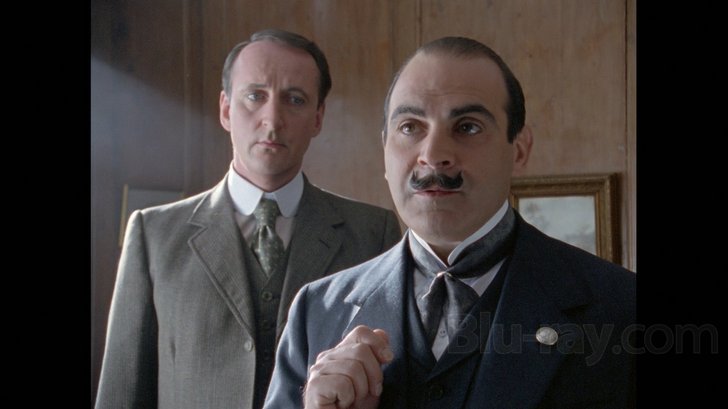
Working their first case . . .
The Mysterious Affair at Styles opens with a marvelous period recreation of London in 1917. Signs of the war are everywhere, as soldiers and military vehicles pass in all directions. Hastings is in hospital recovering from wounds suffered at the front both physical and psychological. A chance encounter with an old friend, John Cavendish (David Rintoul), leads to an invitation to spend the weekend at Styles Court, the Cavendish country home in Essex. Hastings is only too glad for the change of scene, but he quickly discovers that he's stepped into the thick of a family drama. John's mother, the former Emily Cavendish (Gillian Barge), has remarried a shifty and much younger man named Alfred Inglethorp (Michael Cronin), whom John and his brother Lawrence (Anthony Calf) are certain is a fortune hunter. The elderly woman's companion, Evelyn Howard (Joanna McCallum), despises Inglethorp and is certain he plans to harm her mistress. Meanwhile, John and his wife, Mary (Beattie Edney), seem to be having some sort of marital problems. There are tensions, overheard arguments, mysterious comings and goings—in short, not a happy household. All of this would be mere unpleasantness, except that early one morning the elderly Mrs. Inglethorp dies of what is later determined to be strychnine poisoning. As luck would have it, Hastings has encountered another old acquaintance in the village: a certain Belgian detective who arrived in town with a group of his countrymen seeking asylum from "the Bosch" currently occupying his country. Hastings had met Poirot during a trip to Belgium before the war, when Hastings himself had briefly been a suspect in a criminal inquiry, and he'd been duly impressed with the diminutive investigator's astute (if eccentric) methods. At Hastings' suggestion, John Cavendish engages Poirot to probe Mrs. Inglethorp's death, which, in the usual manner of Christie's full-length stories, is the result of an enormously complex scheme that takes a long time and many red herrings to unravel. But justice is ultimately served—and a partnership is born. The one-hour episodes of Series 3 are notable for the variety of locales and circumstances in which Poirot's "little grey cells" are called upon to apply their talents. Rarely in Series 3 do we find Poirot comfortably ensconced in his apartment at Whitehaven Mansions awaiting delivery of his morning tisane from Miss Lemon. Whitehaven Mansions is more likely to be a stopover for checking the mail or packing for departure on some exotic outing. The nomadic nature of Series 3 may have been tough on the show's location scouts and production designers, but it's great fun for the viewer, especially with Blu-ray's ability to render the locations and period recreation in all their detail. Country manors were a favorite setting for Agatha Christie, and in a series of Poirot that begins in Styles Court, it's only fitting that country locales of all sorts should play host to crime and its finest adversary. "Wasp's Nest" takes place in a country village where Poirot meets an old friend, John Harrison (Martin Turner), who is engaged to a pretty model, Molly Deane (Melanie Jessup). Miss Deane used to be involved with a local artist named Claude Langton (Peter Capaldi), but that's all over now. Or is it? Under a placid exterior, Poirot sees crime in the making. In "The Tragedy at Marsdon Manor", Poirot suffers one of the hazards of notoriety. He is summoned to the village of Marsdon Leigh on the pretext of solving a murder, only to learn that the murder is fictional, and his new "client" is a mystery author who can't work out the solution to his own plot. But then a real murder occurs, and Poirot remains to find the culprit. In "The Mystery of Hunter's Lodge", Poirot accompanies Hastings on a weekend shooting party and catches the flu. But no viral infection can slow down "the little grey cells" when the host of the party, Harrington Pace (Bernard Horsfall), is shot dead late Saturday night by a mysterious man who knocks at the door, appearing from nowhere, then disappearing again. In "The Theft of the Royal Ruby", Poirot is literally dragooned into service at Christmas by the Foreign Office so that he can recover a priceless ruby stolen from an Egyptian prince. He must go undercover at the country home of a famous egyptologist, Colonel Lacey (Frederick Treves), who knew the ruby was in England and also happens to be having money problems. Poirot's ostensible purpose for visiting the Laceys is to investigate Desmond Lee-Wortley (Nigel Le Vaillant), the unsavory boyfriend of the colonel's granddaughter, Sarah (Helena Michell). Beneath the holiday merriment, there are strange occurrences: drugged coffee, mysterious warnings about plum pudding, a body on the front lawn and, ultimately, a mad dash to escape in an airplane. In "How Does Your Garden Grow?", Poirot is receiving the singular honor of having a rose named after him, when a lady in a wheelchair, Amelia Barrowby (Margery Mason), solicits his aid. She herself has a fine garden, but when Poirot and Miss Lemon go to visit her in Surrey, it's too late—she's been poisoned. Complicating the picture is the fact that Mrs. Barrowby's attendant, Katrina Reiger (Catherine Russell), is Russian and has been seen visiting the Soviet embassy. "The Million Dollar Bond Robbery" takes Poirot even farther than the English countryside— across the Atlantic with Hastings on the maiden voyage of the Queen Mary, where they have been hired by the London & Scottish Bank to help protect a shipment of bearer bonds. The bonds vanish from a locked strongbox to which only the bank official on board has a key, but Poirot has a different theory (and, of course, he is correct). Even when Poirot remains in London, Series 3 finds him in unique situations. "The Affair at the Victory Ball" sees Poirot take to the BBC to broadcast the solution to a murder that occurred among a group of actors at a masked ball following one of their radio plays. The reaction of the listening public to Poirot's performance is classic. "The Mystery of the Spanish Chest" opens and closes with fencing duels. Poirot must enter a venerable athletic club with a long tradition of dueling to confront the killer. "The Double Clue" offers several spectacles that are unique in the Poirot series. One is Chief Inspector Japp literally begging for Poirot's help, when he faces dismissal for failing to solve high-profile jewel thefts involving members of the aristocracy. The other is Hastings and Miss Lemon attempting to "investigate" on their own, when Poirot seems to be ignoring the case in favor of the charms of a Russian countess, Vera Rossakoff (Kika Markham). The resolution is unlike anything else in Poirot. Finally, there is "The Plymouth Express", perhaps the darkest tale in Poirot to date, which involves an Australian mining magnate, Halliday (John Stone), and his daughter, Florence (Shelagh McLeod), whom her father fears is the target of a fortune hunter. Halliday hires Poirot for what we would now call a "background check", but it turns out that Florence is in even greater danger than anyone suspected. No case that we have seen Poirot handle to date has disturbed him so deeply. A complete list of the episodes follows:
- The Mysterious Affair at Styles (feature-length)
- How Does Your Garden Grow?
- The Million Dollar Bond Robbery
- The Plymouth Express
- Wasps' Nest
- The Tragedy at Marsdon Manor
- The Double Clue
- The Mystery of the Spanish Chest
- The Theft of the Royal Ruby
- The Affair at the Victory Ball
- The Mystery of the Hunter's Lodge
Poirot: Series 3 Blu-ray Movie, Video Quality 
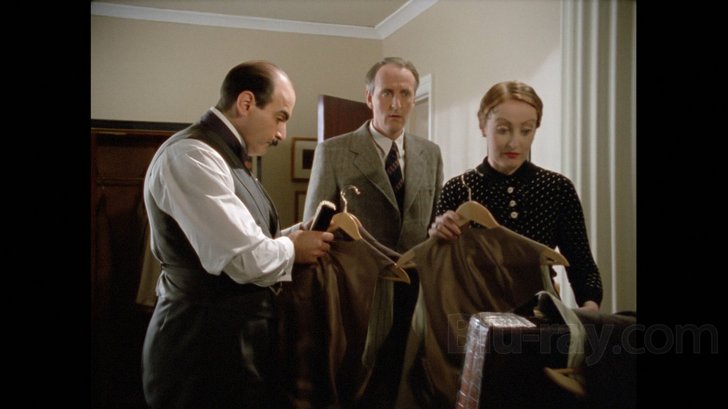
Poirot continued to be shot on 16mm film in these early years. The image on the 1080p, AVC-encoded Blu-rays for Series 3 is consistent with that for Series 2, which is to say that it eschews the somewhat stylized fluorescence of Series 1, preferring a more realistic texture in skin tones, clothing and surfaces. Though the image is on the soft side, the detail remains remarkable and the sharpness is a testament to both the quality of which 16mm photography is capable and the degree to which careful image harvesting can produce a superior Blu-ray from such sources. Black and contrast levels continue to be spot on, and grain is generally well controlled without evidence of any inappropriate digital tampering. As in Series 2, occasional shots are significantly grainier than the norm, and these tend to be night-time scenes photographed from a distance, where lighting conditions would be less than optimal. ("The Tragedy at Marsdon Manor" has more examples than most episodes.) Compression artifacts were non-existent.
Poirot: Series 3 Blu-ray Movie, Audio Quality 
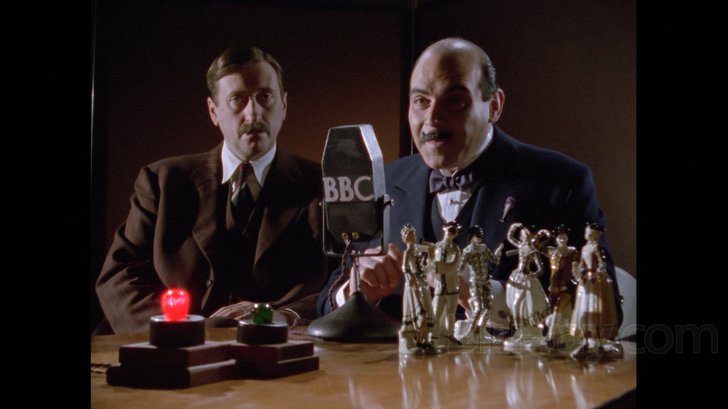
With Series 3, Acorn Media has switched to lossless encoding of Poirot's mono soundtrack, specifically PCM 2.0. This will no doubt be welcome news to those whose "golden ears" can tell the difference between the uncompressed PCM track and the previous two series' DD 2.0. As the preceding sentence probably suggests, I was not struck by any obvious difference. Dialogue remains clear, well-articulated and always intelligible (unless, of course, one has a problem with English or Belgian accents, in which case there are optional subtitles). Christopher Gunning's memorable theme, in its many arrangements and variations, plus the incidental music by various composers (including Gunning and Richard Hewson), continues to have a pleasant musicality and excellent bass extension. The track may be monaural, but it has real presence. I prefer to leave my system's matrix decoder engaged, which causes the two identical channels to collapse to the center speaker. When played through a good set of stereo speakers in "direct" mode, the track should provide a wide soundstage, much like a typical theatrical array.
Poirot: Series 3 Blu-ray Movie, Special Features and Extras 
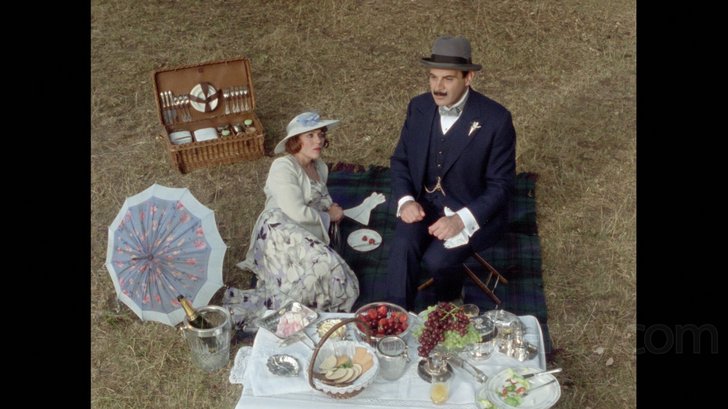
Other than introductory trailers on disc 1 for Acorn Media, Going Postal and Murdoch Mysteries, no extras are included.
Poirot: Series 3 Blu-ray Movie, Overall Score and Recommendation 

What more is there to say? By this point in its history, everyone involved in Poirot had thoroughly mastered their craft, and the series had reached its height. Later years would bring debates over whether too many creative liberties were being taken with Christie's vision (these rose to a crescendo with the adaptation of Murder on the Orient Express), but that era lay in the future. This is a season that any serious fan of Hercule Poirot must add to their Blu-ray collection. Highest recommendation.
Other editions
Poirot: Other Seasons

Poirot: Series 1
1989

Poirot: Series 2
1990

Poirot: Series 4
1992

Poirot: Series 5
1993

Poirot: Series 6
1995-1996

Poirot: Series 7 & 8
2000-2001

Poirot: Series 9
2003-2004

Agatha Christie's Death on the Nile
2004

Poirot: Series 10
2006

Poirot: Series 11
2008-2009

Poirot: The Movie Collection - Set 6
2009-2010

Poirot: Murder on the Orient Express
2010

Poirot: Series 12
2010-2011

Poirot: Series 13
2013
Similar titles
Similar titles you might also like
(Still not reliable for this title)

The Mirror Crack'd
1980

State of Play
2009

Murdoch Mysteries: Season 18
The Artful Detective
2024-2025

Zodiac 4K
Theatrical 4K | Director's Cut BD only
2007

Foyle's War: Set 8
2014

The Night of the Generals
Limited Edition to 3000 - SOLD OUT
1967

Murder on the Orient Express 4K
50th Anniversary Edition
1974

Miss Marple: Volume 1
The Murder at the Vicarage / The Body in the Library / The Moving Finger / A Murder is Announced
1984-1986

The Raven
2012

Murder on the Orient Express
2017

Twisted
2004

The Black Dahlia
2006

Evil Under the Sun
1982

Gosford Park
Arrow Academy
2001

Crooked House
2017

The Girl with the Dragon Tattoo
2011

The Bone Collector 4K
1999

Murder by Decree 4K
1979

Taboo: Season One
2017

L.A. Confidential
1997